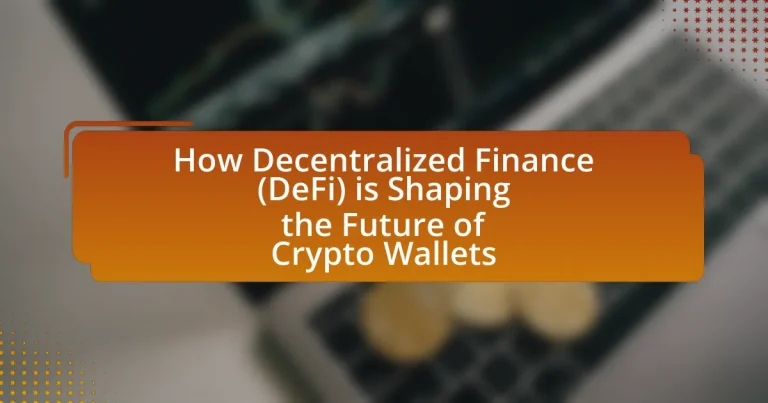Decentralized Finance (DeFi) is significantly reshaping the future of crypto wallets by enabling direct user interaction with financial services on the blockchain, eliminating intermediaries. This transformation enhances user control over assets and integrates functionalities such as lending, borrowing, and yield farming into wallet interfaces. Key principles of DeFi, including transparency, accessibility, and security, are driving the evolution of crypto wallets, which now support features like multi-signature authentication and decentralized exchanges. However, challenges such as security vulnerabilities and usability issues persist, impacting user adoption. Future trends indicate a focus on interoperability, compliance with regulatory requirements, and the integration of advanced security measures, all of which will further influence wallet development in the DeFi ecosystem.
-Transforming-the-Landscape-of-Crypto-Wallets-1.webp)
How is Decentralized Finance (DeFi) Transforming the Landscape of Crypto Wallets?
Decentralized Finance (DeFi) is transforming the landscape of crypto wallets by enabling users to interact directly with financial services without intermediaries. This shift allows for greater control over assets, as DeFi wallets facilitate features such as lending, borrowing, and yield farming directly on the blockchain. According to a report by ConsenSys, the total value locked in DeFi protocols reached over $80 billion in 2021, highlighting the increasing reliance on DeFi solutions. Consequently, crypto wallets are evolving to integrate these functionalities, providing users with seamless access to decentralized applications (dApps) and enhancing the overall user experience in managing digital assets.
What are the fundamental principles of Decentralized Finance (DeFi)?
The fundamental principles of Decentralized Finance (DeFi) include transparency, accessibility, programmability, and security. Transparency is achieved through blockchain technology, allowing all transactions to be publicly verifiable. Accessibility ensures that anyone with an internet connection can participate in financial services without intermediaries. Programmability refers to the use of smart contracts, which automate and enforce agreements without the need for a central authority. Security is enhanced through cryptographic techniques that protect user assets and data. These principles collectively enable a more open and inclusive financial system, as evidenced by the rapid growth of DeFi platforms, which saw total value locked in DeFi protocols exceed $80 billion in 2021, demonstrating significant user adoption and trust in these systems.
How does DeFi differ from traditional finance?
DeFi differs from traditional finance primarily in its decentralized nature, which eliminates intermediaries like banks and financial institutions. In DeFi, transactions occur directly between users through smart contracts on blockchain networks, enhancing transparency and reducing costs. Traditional finance relies on centralized authorities to manage transactions, enforce regulations, and provide services, which can lead to inefficiencies and higher fees. For example, DeFi platforms like Uniswap allow users to trade cryptocurrencies without a central exchange, showcasing the efficiency and lower transaction costs compared to traditional trading platforms.
What role do smart contracts play in DeFi?
Smart contracts are essential in DeFi as they automate and enforce the execution of financial agreements without intermediaries. They facilitate transactions, lending, borrowing, and trading on decentralized platforms by executing predefined conditions coded within the contract. For instance, platforms like Uniswap utilize smart contracts to enable automated trading of cryptocurrencies, ensuring that trades occur only when specific conditions are met, thus enhancing security and efficiency. The use of smart contracts eliminates the need for trust in third parties, as the code itself governs the transactions, which is a foundational principle of DeFi.
Why are crypto wallets essential in the DeFi ecosystem?
Crypto wallets are essential in the DeFi ecosystem because they enable users to securely store, manage, and interact with their digital assets. These wallets facilitate transactions, allowing users to participate in decentralized applications (dApps) and access various financial services without intermediaries. According to a report by ConsenSys, over 50% of DeFi users rely on non-custodial wallets, which provide users full control over their private keys and funds, enhancing security and autonomy. This reliance on crypto wallets underscores their critical role in enabling seamless and secure participation in the rapidly evolving DeFi landscape.
What types of crypto wallets are commonly used in DeFi?
The types of crypto wallets commonly used in DeFi include hot wallets, cold wallets, and hardware wallets. Hot wallets, which are connected to the internet, facilitate quick transactions and are often used for trading and liquidity provision. Cold wallets, on the other hand, are offline storage solutions that provide enhanced security for long-term asset holding. Hardware wallets, a subset of cold wallets, offer a physical device for secure key management, making them a popular choice among users prioritizing security. According to a report by Chainalysis, the use of hardware wallets has increased significantly as users seek to protect their assets from hacks and thefts, highlighting the importance of security in the DeFi ecosystem.
How do crypto wallets enhance user control and security in DeFi?
Crypto wallets enhance user control and security in DeFi by allowing individuals to manage their private keys and funds directly, eliminating reliance on centralized entities. This direct management means users retain full ownership of their assets, reducing the risk of hacks or fraud associated with centralized exchanges. Furthermore, many crypto wallets incorporate advanced security features such as multi-signature authentication and biometric access, which provide additional layers of protection against unauthorized access. According to a report by Chainalysis, decentralized finance platforms have seen a significant increase in user adoption, with over $80 billion locked in DeFi protocols as of 2021, highlighting the growing trust in user-controlled wallets for secure transactions.
What challenges do crypto wallets face in the DeFi space?
Crypto wallets face several challenges in the DeFi space, primarily related to security, interoperability, and user experience. Security risks include vulnerabilities to hacks and phishing attacks, as evidenced by the $1.9 billion lost to DeFi hacks in 2021 alone. Interoperability issues arise from the diverse protocols and standards across different DeFi platforms, making it difficult for wallets to support multiple assets seamlessly. Additionally, user experience challenges stem from the complexity of managing private keys and navigating decentralized applications, which can deter mainstream adoption. These factors collectively hinder the effectiveness and usability of crypto wallets in the rapidly evolving DeFi landscape.
How do security vulnerabilities impact crypto wallets in DeFi?
Security vulnerabilities significantly compromise crypto wallets in DeFi by exposing them to theft, loss of funds, and unauthorized access. For instance, vulnerabilities such as smart contract bugs or phishing attacks can lead to substantial financial losses; in 2021 alone, DeFi protocols suffered over $1.3 billion in hacks due to these weaknesses. Additionally, the decentralized nature of DeFi means that once a wallet is compromised, recovery options are limited, making it crucial for users to employ robust security measures to protect their assets.
What are the usability issues associated with DeFi wallets?
Usability issues associated with DeFi wallets include complex user interfaces, lack of customer support, and security concerns. Complex user interfaces often overwhelm users, especially those unfamiliar with blockchain technology, leading to mistakes in transactions. The absence of customer support can leave users stranded when they encounter issues, as many DeFi wallets operate without centralized assistance. Additionally, security concerns arise from the self-custody nature of DeFi wallets, where users are responsible for their private keys, increasing the risk of loss or theft. These factors collectively hinder user adoption and satisfaction in the DeFi space.

How are Innovations in DeFi Influencing the Development of Crypto Wallets?
Innovations in DeFi are significantly influencing the development of crypto wallets by integrating advanced functionalities such as decentralized exchanges, yield farming, and lending protocols directly into wallet interfaces. These enhancements allow users to manage their assets more efficiently and engage in complex financial activities without needing separate platforms. For instance, wallets now often include features that enable users to stake tokens or earn interest on their holdings, reflecting the growing trend of providing comprehensive financial services within a single application. This shift is supported by the increasing demand for user-friendly interfaces that simplify access to DeFi services, as evidenced by the rise in multi-functional wallets like MetaMask and Trust Wallet, which have seen substantial user growth and adoption rates.
What new features are emerging in crypto wallets due to DeFi?
New features emerging in crypto wallets due to DeFi include integrated decentralized exchanges (DEXs), yield farming capabilities, and multi-chain support. Integrated DEXs allow users to trade assets directly within their wallets without needing to transfer funds to external platforms, enhancing convenience and security. Yield farming capabilities enable users to earn interest on their crypto holdings by participating in liquidity pools directly from their wallets, thus maximizing asset utility. Multi-chain support facilitates transactions across various blockchain networks, allowing users to manage diverse assets seamlessly in one wallet. These features reflect the growing trend of enhancing user experience and functionality in crypto wallets as DeFi continues to evolve.
How are multi-signature wallets changing the DeFi landscape?
Multi-signature wallets are transforming the DeFi landscape by enhancing security and governance. These wallets require multiple private keys to authorize a transaction, significantly reducing the risk of theft or loss associated with single-key wallets. According to a report by Chainalysis, multi-signature wallets have been instrumental in securing over $1 billion in assets, demonstrating their effectiveness in protecting funds. Additionally, they facilitate decentralized governance by allowing multiple stakeholders to participate in decision-making processes, thereby promoting transparency and trust within DeFi protocols. This shift towards collaborative control is reshaping how users interact with decentralized applications and manage their assets.
What is the significance of wallet interoperability in DeFi?
Wallet interoperability in DeFi is significant because it enables seamless interaction between different decentralized applications and protocols, enhancing user experience and liquidity. This interoperability allows users to manage assets across multiple platforms without the need for multiple wallets, thereby simplifying transactions and reducing friction. For instance, a study by ConsenSys in 2021 highlighted that interoperability can lead to increased capital efficiency, as users can easily move assets between various DeFi services, optimizing yield and minimizing costs.
How are user experiences evolving with DeFi wallets?
User experiences with DeFi wallets are evolving through enhanced usability, security features, and integration with decentralized applications (dApps). As DeFi wallets increasingly prioritize user-friendly interfaces, they simplify complex processes like trading and yield farming, making them accessible to a broader audience. Additionally, advancements in security protocols, such as multi-signature authentication and biometric verification, bolster user confidence in managing their assets. Furthermore, the seamless integration of DeFi wallets with dApps allows users to interact directly with various financial services, streamlining transactions and improving overall engagement. This evolution is supported by the growing adoption of DeFi platforms, which reported a surge in total value locked (TVL) from approximately $1 billion in early 2020 to over $80 billion by late 2021, indicating a significant shift in user interaction with decentralized finance.
What role does user interface design play in DeFi wallet adoption?
User interface design significantly influences DeFi wallet adoption by enhancing user experience and accessibility. A well-designed interface simplifies complex functionalities, making it easier for users to navigate and utilize various features, which is crucial in attracting both novice and experienced users. Research indicates that 94% of first impressions relate to design, highlighting the importance of an intuitive interface in retaining users. Furthermore, effective user interface design can reduce the learning curve associated with DeFi wallets, thereby increasing user confidence and encouraging broader adoption in the decentralized finance ecosystem.
How are educational resources impacting user engagement with DeFi wallets?
Educational resources significantly enhance user engagement with DeFi wallets by increasing users’ understanding and confidence in utilizing these financial tools. When users access comprehensive guides, tutorials, and webinars, they become more informed about the functionalities and benefits of DeFi wallets, leading to higher adoption rates. For instance, a study by the Cambridge Centre for Alternative Finance found that educational initiatives can increase user participation in DeFi platforms by up to 30%, as users feel more equipped to navigate the complexities of decentralized finance. This increased knowledge directly correlates with greater user interaction and investment in DeFi wallets, demonstrating the critical role of education in fostering engagement.

What Future Trends Can We Expect for Crypto Wallets in the DeFi Space?
Future trends for crypto wallets in the DeFi space include enhanced interoperability, increased security features, and the integration of decentralized identity solutions. Interoperability will allow users to seamlessly interact with multiple DeFi platforms, driven by protocols like Polkadot and Cosmos, which facilitate cross-chain transactions. Security enhancements will focus on multi-signature wallets and hardware wallet integrations to protect assets from hacks, as evidenced by the rise in DeFi hacks, which totaled over $1.3 billion in 2021 alone. Additionally, decentralized identity solutions will enable users to maintain control over their personal data while accessing various DeFi services, aligning with the growing emphasis on privacy and user autonomy in the blockchain ecosystem.
How will regulatory changes affect the future of DeFi wallets?
Regulatory changes will significantly impact the future of DeFi wallets by imposing compliance requirements that could alter their operational frameworks. As governments and regulatory bodies increasingly focus on consumer protection, anti-money laundering (AML), and know-your-customer (KYC) regulations, DeFi wallets may need to integrate these protocols to remain viable. For instance, the Financial Action Task Force (FATF) has recommended that virtual asset service providers implement KYC measures, which could lead to a shift from fully decentralized models to hybrid systems that incorporate some level of centralization for compliance purposes. This transition may affect user privacy and the fundamental principles of decentralization that DeFi wallets are built upon.
What potential impacts could government regulations have on wallet functionalities?
Government regulations could significantly restrict wallet functionalities by imposing compliance requirements such as Know Your Customer (KYC) and Anti-Money Laundering (AML) protocols. These regulations may necessitate that wallet providers collect and verify user identities, which could limit the anonymity and privacy features that many users value in decentralized finance (DeFi) environments. For instance, the Financial Action Task Force (FATF) has recommended that countries enforce these measures, leading to potential limitations on peer-to-peer transactions and increased scrutiny of wallet activities. Consequently, such regulations could hinder the seamless user experience and operational flexibility that decentralized wallets currently offer.
How might compliance requirements shape wallet development?
Compliance requirements significantly influence wallet development by necessitating features that ensure regulatory adherence, such as Know Your Customer (KYC) and Anti-Money Laundering (AML) protocols. These requirements compel developers to integrate identity verification processes and transaction monitoring systems into wallets, which can enhance security and trust among users. For instance, the Financial Action Task Force (FATF) guidelines mandate that virtual asset service providers implement robust compliance measures, leading to the adoption of advanced technologies like biometric authentication and real-time transaction analysis in wallet design. Consequently, compliance not only shapes the technical specifications of wallets but also impacts user experience and market acceptance, as wallets that meet regulatory standards are more likely to gain traction in jurisdictions with stringent laws.
What best practices should users follow when using DeFi wallets?
Users should follow several best practices when using DeFi wallets to ensure security and efficiency. First, users must enable two-factor authentication (2FA) to add an extra layer of security to their accounts, which significantly reduces the risk of unauthorized access. Additionally, users should regularly update their wallet software to protect against vulnerabilities, as updates often include security patches.
Moreover, users are advised to store their private keys securely and never share them, as possession of these keys grants full control over the wallet’s assets. Utilizing hardware wallets for significant amounts of cryptocurrency is also recommended, as these devices provide offline storage, making them less susceptible to hacking.
Lastly, users should conduct thorough research on the DeFi platforms they interact with, ensuring they are reputable and have undergone security audits, as this can mitigate the risk of scams and loss of funds. Following these practices can enhance the security and reliability of using DeFi wallets.
How can users ensure the security of their crypto wallets?
Users can ensure the security of their crypto wallets by implementing strong security practices such as using hardware wallets, enabling two-factor authentication, and regularly updating wallet software. Hardware wallets, which store private keys offline, significantly reduce the risk of hacking, as they are less vulnerable to online threats. Two-factor authentication adds an extra layer of security by requiring a second form of verification, making unauthorized access more difficult. Regularly updating wallet software ensures that users benefit from the latest security patches and features, protecting against newly discovered vulnerabilities. These practices are essential in safeguarding digital assets in the evolving landscape of decentralized finance.
What strategies can enhance the usability of DeFi wallets for everyday transactions?
To enhance the usability of DeFi wallets for everyday transactions, integrating user-friendly interfaces and simplifying the onboarding process are essential strategies. User-friendly interfaces can include intuitive navigation, clear labeling of functions, and streamlined transaction processes, which reduce the learning curve for new users. Simplifying the onboarding process involves providing easy-to-follow tutorials and support resources that guide users through wallet setup and transaction execution. Research indicates that 70% of users abandon complex platforms due to usability issues, highlighting the importance of these strategies in retaining users and facilitating regular transactions.


